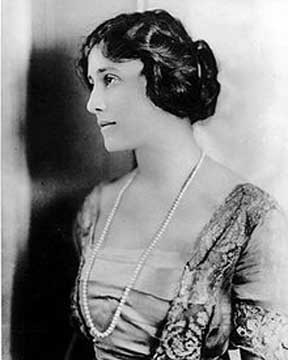Charles Cary Rumsey - Table of Contents
Bio - Mary Harriman Rumsey
1881 - 1934
Inductee, National Women's Hall of Fame
Text Beneath Illustrations
 ....... ....... Source: Wikipedia: Mary Harriman Rumsey (online August 2015) |
| Excerpts Mary Harriman By Susan Chavez National Women's History Museum: Mary Harriman (online August 2015) Born on November 17, 1881, Mary
Harriman was the oldest of six children to railroad industrialist, E.H.
Harriman. Mary’s family was among the wealthiest in America at the turn
of the twentieth century.
Mary, a bright student, expressed her intention to enroll in Barnard College, the relatively new female affiliate to New York City’s Columbia University. Mary’s father initially resisted: young women of Mary’s age and class were expected to debut and then marry; very few had any education beyond that of governesses and finishing schools. Unable to say no to his favorite child, Harriman relented. In 1901, while a student at Barnard College, Mary and a group of 80 debutantes from New York City’s most prominent families formally established the Junior League for the Promotion of Settlements Movements, now known as The Junior League of the City of New York. The purpose of The Junior League would be to unite social prominent young women to work for the needy. Among The Junior League’s earliest members was Mary’s good friend, Eleanor Roosevelt... The Junior League would serve as launching pad for many women who went on to make a name for themselves in public service, including Sandra Day O’Connor, Margaret Chase Smith, and Shirley Temple. The latter part of her life would be defined by her continued philanthropic efforts, work with farming cooperatives and entrance into the worlds of publishing and politics. This was especially true after the untimely death of her husband, the sculptor and polo player, [Charles] Cary Rumsey. Harriman had long expressed an interest in publishing, believing it to be the best forum for expressing her liberal progressive philosophies. After a couple of failed attempts in the newspaper industry, she decided to found a newsmagazine that would serve as a liberal counterpoint to newsmagazines in circulation at the time. In 1932, Mary, along with her younger brother, future diplomat Averell Harriman, and several close colleagues founded the newsmagazine, Today, which would later merge with and become Newsweek. The following year, President Franklin Roosevelt appointed her to a major agency dealing with the Great Depression: she chaired the Consumer Advisory Board (CAB) of the National Recovery Administration (NRA), the United States’ first consumer rights panel. In addition to being one of two women to serve on the powerful NRA, she helped write the Social Security Act with others, including her close friend and fellow Junior Leaguer, Labor Secretary Frances Perkins. |
| Excerpts Mary Harriman Rumsey Wikipedia: Mary Harriman Rumsey (online August 2015) Mary married sculptor and polo
player Charles Cary Rumsey in 1910, shortly after the death of her
father. Rumsey had been working at Arden House, creating one of the
principal fireplace surrounds, as well as other decorative sculpture.
Together they had a daughter and two sons.
Charles was killed in a car accident in 1922. Mary died in 1934 as a result of a horse riding accident which occurred while on a hunt near Middleburg, Virginia. |
| Excerpts Women of Long Island: Mary Williamson Averell Harriman; her daughter, Mary Harriman Rumsey by Judith Ader Spinzia 2008 (online August 2015) Prior to the death of E. H.
Harriman [Mary's gather], Willard Dickerman Straight had proposed
marriage to Mary. Their intention to marry was rejected by her father,
who refused to have the young diplomat as a son- in-law.
Mary again faced family opposition when she decided to marry Charles Cary Rumsey, Sr. Mrs. Harriman and Mary’s brother Averell had been opposed to Mary’s marriage to Rumsey because of his reputation for excessive drinking. Mary persevered and she and Charles were married in 1910. Charles Cary Rumsey, Sr. was a 1902 Harvard graduate and talented sculptor from Buffalo, NY, who had been among the artists who had been hired to decorate Arden House [an 1885 Queen Anne-style house, designed by Robert W. Gibson, in the Wave Crest Park section of Far Rockaway(. He and Mary had met in 1906 at the Meadow Brook Club in the Town of Hempstead [in the area known as East Garden City today) and were instantly attracted to each other because of their love of horses. In 1910, Mary and Pad, as he was known, built their Dutch Colonial Long Island country home on Wheatly Road in Brookville, the activities at which revolved around their mutual love of horses, Pad’s passion for polo, and the world of art. Anxious to remain involved in the farm life she had known at Arden House, Mary purchased a farm near Middleburg, VA, in an enclave then known as The Plains, which became a place for family time and a center of cattle breeding where Mary applied her interest in genetics. Even after Charles’ death in 1922, she maintained the Virginia farm while raising her three young children - Charles Cary Rumsey, Jr. was eleven-years-old when his father died, Mary Averell Harriman Rumsey was nine, and Bronson Harriman Rumsey was just five years of age. -------- In September 1922 Charles Rumsey was killed at the intersection of Jericho Turnpike and Tulip Avenue in Floral Park when the convertible automobile in which he was a passenger over-turned. He was traveling home from polo practice with friends to join his wife Mary who was returning there after attending the marriage of Katherine Mackay to Kenneth O’Brien in St. Mary’s Church in Roslyn. |